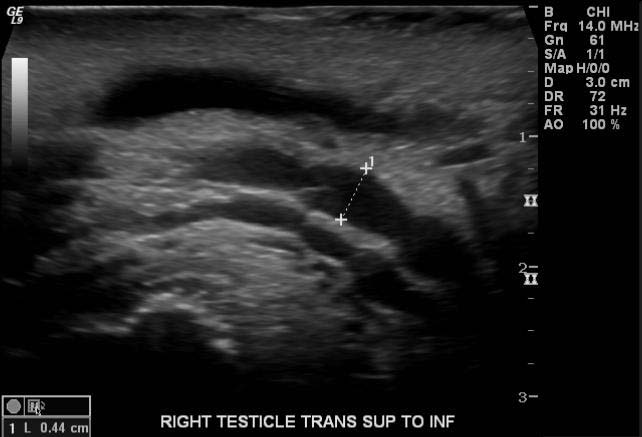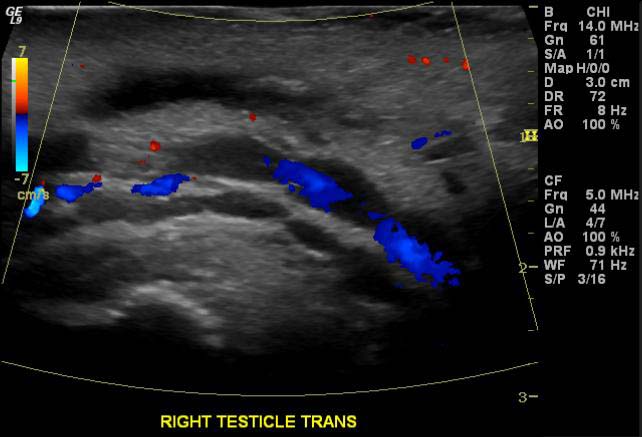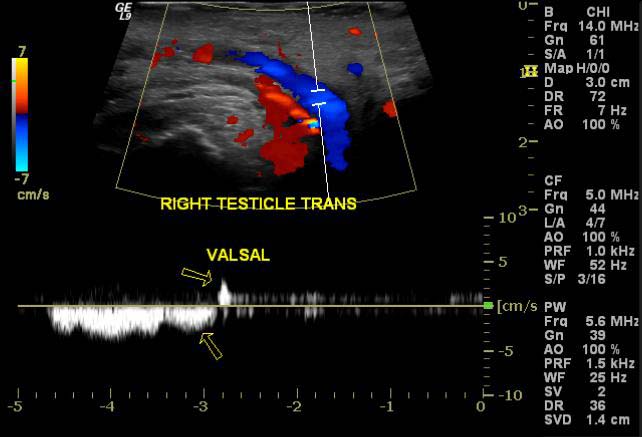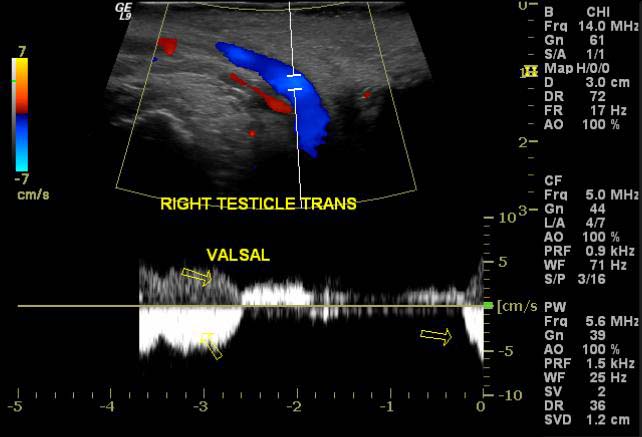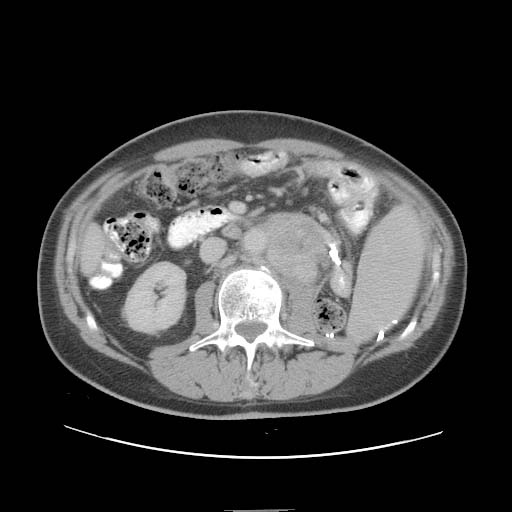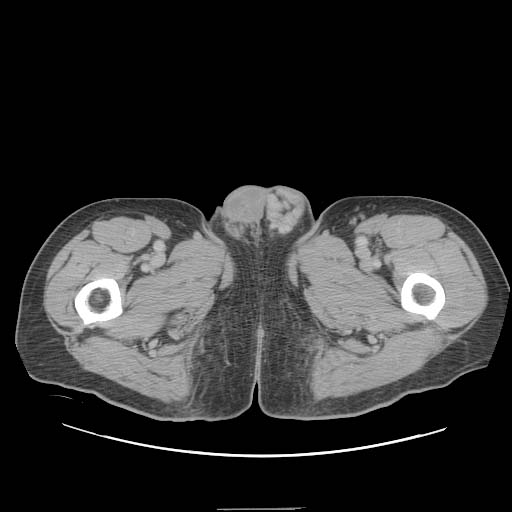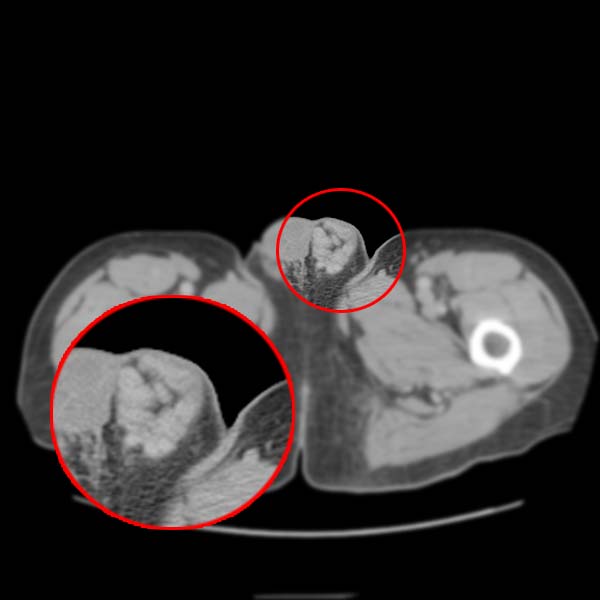Varicocele: Difference between revisions
No edit summary |
No edit summary |
||
| Line 19: | Line 19: | ||
'''Varicocele''' is an abnormal enlargement of the [[vein]]s in the [[scrotum]] draining the [[testicles]]. The testicular [[blood vessels]] originate in the abdomen and course down through the [[inguinal canal]] as part of the [[spermatic cord]] on their way to the [[testis]]. Up-ward flow of blood in the veins is ensured by small one-way valves that prevent backflow. Defective valves, or compression of the vein by a nearby structure, can cause dilatation of the veins near the testis, leading to the formation of a varicocele. | '''Varicocele''' is an abnormal enlargement of the [[vein]]s in the [[scrotum]] draining the [[testicles]]. The testicular [[blood vessels]] originate in the abdomen and course down through the [[inguinal canal]] as part of the [[spermatic cord]] on their way to the [[testis]]. Up-ward flow of blood in the veins is ensured by small one-way valves that prevent backflow. Defective valves, or compression of the vein by a nearby structure, can cause dilatation of the veins near the testis, leading to the formation of a varicocele. | ||
== | ==Pathophysiology== | ||
The term varicocele specifically refers to dilatation and tortuosity of the [[pampiniform plexus]], which is the network of veins that drain the testicle. This plexus travels along the posterior portion of the testicle with the epididymis and vas deferens, and then into the spermatic cord. This network of veins coalesces into the gonadal, or testicular, vein. The right gonadal vein drains into the [[inferior vena cava]], while the left gonadal vein drains into the left [[renal vein]] at right angle to the renal vein, which then drains into the inferior vena cava. | The term varicocele specifically refers to dilatation and tortuosity of the [[pampiniform plexus]], which is the network of veins that drain the testicle. This plexus travels along the posterior portion of the testicle with the epididymis and vas deferens, and then into the spermatic cord. This network of veins coalesces into the gonadal, or testicular, vein. The right gonadal vein drains into the [[inferior vena cava]], while the left gonadal vein drains into the left [[renal vein]] at right angle to the renal vein, which then drains into the inferior vena cava. | ||
The small vessels of the pampiniform plexus normally range from 0.5-1.5 mm in diameter. Dilatation of these vessels greater than 2 mm is called a varicocele. | The small vessels of the pampiniform plexus normally range from 0.5-1.5 mm in diameter. Dilatation of these vessels greater than 2 mm is called a varicocele. | ||
The '''idiopathic varicocele''' occurs when the valves within the veins along the spermatic cord don't work properly. This is essentially the same process as [[varicose veins]], which are common in the legs. This results in backflow of blood into the pampiniform plexus and causes increased pressures, ultimately leading to damage to the testicular tissue. | The '''idiopathic varicocele''' occurs when the valves within the veins along the spermatic cord don't work properly. This is essentially the same process as [[varicose veins]], which are common in the legs. This results in backflow of blood into the pampiniform plexus and causes increased pressures, ultimately leading to damage to the testicular tissue. | ||
| Line 33: | Line 32: | ||
A '''secondary varicocele''' is due to compression of the venous drainage of the testicle. A pelvic or abdominal malignancy is a definite concern when a varicocele is newly diagnosed in a patient older than 40 years of age. One non-malignant cause of a secondary varicocele is the so-called "nut-cracker SMA" (superior mesenteric artery), a condition in which the superior mesenteric artery compresses the left renal vein, causing increased pressures there to be transmitted retrograde into the left pampiniform plexus. | A '''secondary varicocele''' is due to compression of the venous drainage of the testicle. A pelvic or abdominal malignancy is a definite concern when a varicocele is newly diagnosed in a patient older than 40 years of age. One non-malignant cause of a secondary varicocele is the so-called "nut-cracker SMA" (superior mesenteric artery), a condition in which the superior mesenteric artery compresses the left renal vein, causing increased pressures there to be transmitted retrograde into the left pampiniform plexus. | ||
==Symptoms== | ==Natural History, Complications, Prognosis== | ||
A varicocele is usually harmless and sometimes requires no treatment. If surgery is required because of infertility or testicular atrophy, the outlook is usually excellent. Removal of varicocele can lead to normal testicular temperatures and an increased sperm production. | |||
Whether or not a varicocele causes infertility is a contentious issue. Recent research suggests that there may be no improvement in fertility after treating a varicocele with surgery; indeed, the research implies that there may not even be a reliable causal link between the presence of a varicocele and infertility in males <ref>[http://news.bbc.co.uk/1/hi/health/2948122.stm BBC News: Varicocele] </ref>. | |||
==Diagnosis== | |||
===Symptoms=== | |||
Symptoms of varicocele may include: | Symptoms of varicocele may include: | ||
* Dragging and aching pain in the [[scrotum]]. | * Dragging and aching pain in the [[scrotum]]. | ||
| Line 41: | Line 46: | ||
* Visible or palpable (able to be felt) enlarged vein<ref>[http://www.urologychannel.com/varicocele/symptoms.shtml Urologychannel: Varicoele] - URL retrieved October 21, 2006</ref> | * Visible or palpable (able to be felt) enlarged vein<ref>[http://www.urologychannel.com/varicocele/symptoms.shtml Urologychannel: Varicoele] - URL retrieved October 21, 2006</ref> | ||
== | ===Physical examination=== | ||
Upon palpation of the scrotum, a non-tender, twisted mass along the spermatic cord is felt (it feels like a bag of worms.) The mass may not be obvious, especially when lying down. The testicle on the side of the varicocele may or may not be smaller compared to the other side. | Upon palpation of the scrotum, a non-tender, twisted mass along the spermatic cord is felt (it feels like a bag of worms.) The mass may not be obvious, especially when lying down. The testicle on the side of the varicocele may or may not be smaller compared to the other side. | ||
===Ultrasound=== | |||
Varicocele can be reliably diagnosed with [[ultrasound]], which will show dilatation of the vessels of the pampiniform plexus to greater than 2 mm. The patient being studied should undergo a provocative maneuver, such as a [[Valsalva maneuver |Valsalva maneuver]] (straining, like he is trying to have a bowel movement) or standing up during the exam, both of which are designed to increase intraabdominal venous pressure and increase the dilatation of the veins. Doppler ultrasound is a technique of measuring the speed at which blood is flowing in a vessel. An ultrasound machine that has a Doppler mode can see blood reverse direction in a varicocele with a Valsalva, increasing the sensitivity of the examination. | Varicocele can be reliably diagnosed with [[ultrasound]], which will show dilatation of the vessels of the pampiniform plexus to greater than 2 mm. The patient being studied should undergo a provocative maneuver, such as a [[Valsalva maneuver |Valsalva maneuver]] (straining, like he is trying to have a bowel movement) or standing up during the exam, both of which are designed to increase intraabdominal venous pressure and increase the dilatation of the veins. Doppler ultrasound is a technique of measuring the speed at which blood is flowing in a vessel. An ultrasound machine that has a Doppler mode can see blood reverse direction in a varicocele with a Valsalva, increasing the sensitivity of the examination. | ||
<gallery> | <gallery> | ||
| Line 71: | Line 75: | ||
An alternative to surgery is embolisation, a non-invasive treatment for varicocele that is performed by an [[interventional radiologist]]. This involves passing a small wire through a peripheral vein and into the abdominal veins that drain the testes. Through a small flexible [[catheter]], this doctor can obstruct the veins so that the increased pressures from the abdomen are no longer transmitted to the testicles. The testicles then drain through a bunch of smaller, collateral veins. The recovery period is significantly less than with surgery and the risk of complications is minimised. However, overall effectiveness is not as high as surgery, which is still an option. | An alternative to surgery is embolisation, a non-invasive treatment for varicocele that is performed by an [[interventional radiologist]]. This involves passing a small wire through a peripheral vein and into the abdominal veins that drain the testes. Through a small flexible [[catheter]], this doctor can obstruct the veins so that the increased pressures from the abdomen are no longer transmitted to the testicles. The testicles then drain through a bunch of smaller, collateral veins. The recovery period is significantly less than with surgery and the risk of complications is minimised. However, overall effectiveness is not as high as surgery, which is still an option. | ||
==References== | ==References== | ||
Revision as of 14:03, 1 August 2012
For the patient information page, click here
Template:DiseaseDisorder infobox Template:Search infobox Steven C. Campbell, M.D., Ph.D.
Overview
Varicocele is an abnormal enlargement of the veins in the scrotum draining the testicles. The testicular blood vessels originate in the abdomen and course down through the inguinal canal as part of the spermatic cord on their way to the testis. Up-ward flow of blood in the veins is ensured by small one-way valves that prevent backflow. Defective valves, or compression of the vein by a nearby structure, can cause dilatation of the veins near the testis, leading to the formation of a varicocele.
Pathophysiology
The term varicocele specifically refers to dilatation and tortuosity of the pampiniform plexus, which is the network of veins that drain the testicle. This plexus travels along the posterior portion of the testicle with the epididymis and vas deferens, and then into the spermatic cord. This network of veins coalesces into the gonadal, or testicular, vein. The right gonadal vein drains into the inferior vena cava, while the left gonadal vein drains into the left renal vein at right angle to the renal vein, which then drains into the inferior vena cava.
The small vessels of the pampiniform plexus normally range from 0.5-1.5 mm in diameter. Dilatation of these vessels greater than 2 mm is called a varicocele.
The idiopathic varicocele occurs when the valves within the veins along the spermatic cord don't work properly. This is essentially the same process as varicose veins, which are common in the legs. This results in backflow of blood into the pampiniform plexus and causes increased pressures, ultimately leading to damage to the testicular tissue.
Varicoceles usually develop slowly and may not have any symptoms. There are most frequently diagnosed when a patient is 15-25 years of age, and rarely develop after the age of 40. They occur in 15-20% of all males, and in 40% of infertile males.
98% of idiopathic varicoceles occur on the left side, apparently because the left testicular vein runs vertically up to the renal vein, while the right testicular vein drains directly into the vena cava. Isolated right sided varicoceles are rare, and should prompt evaluation for an abdominal or pelvic mass (see secondary varicocele, below).
A secondary varicocele is due to compression of the venous drainage of the testicle. A pelvic or abdominal malignancy is a definite concern when a varicocele is newly diagnosed in a patient older than 40 years of age. One non-malignant cause of a secondary varicocele is the so-called "nut-cracker SMA" (superior mesenteric artery), a condition in which the superior mesenteric artery compresses the left renal vein, causing increased pressures there to be transmitted retrograde into the left pampiniform plexus.
Natural History, Complications, Prognosis
A varicocele is usually harmless and sometimes requires no treatment. If surgery is required because of infertility or testicular atrophy, the outlook is usually excellent. Removal of varicocele can lead to normal testicular temperatures and an increased sperm production.
Whether or not a varicocele causes infertility is a contentious issue. Recent research suggests that there may be no improvement in fertility after treating a varicocele with surgery; indeed, the research implies that there may not even be a reliable causal link between the presence of a varicocele and infertility in males [1].
Diagnosis
Symptoms
Symptoms of varicocele may include:
- Dragging and aching pain in the scrotum.
- Feeling of heaviness in the testicle(s)
- Infertility
- Shrinkage (atrophy) of the testicle(s)
- Visible or palpable (able to be felt) enlarged vein[2]
Physical examination
Upon palpation of the scrotum, a non-tender, twisted mass along the spermatic cord is felt (it feels like a bag of worms.) The mass may not be obvious, especially when lying down. The testicle on the side of the varicocele may or may not be smaller compared to the other side.
Ultrasound
Varicocele can be reliably diagnosed with ultrasound, which will show dilatation of the vessels of the pampiniform plexus to greater than 2 mm. The patient being studied should undergo a provocative maneuver, such as a Valsalva maneuver (straining, like he is trying to have a bowel movement) or standing up during the exam, both of which are designed to increase intraabdominal venous pressure and increase the dilatation of the veins. Doppler ultrasound is a technique of measuring the speed at which blood is flowing in a vessel. An ultrasound machine that has a Doppler mode can see blood reverse direction in a varicocele with a Valsalva, increasing the sensitivity of the examination.
-
Varicocele
-
Varicocele
-
Varicocele
-
Varicocele
CT Findings
-
Varicocele
-
Varicocele
-
Varicocele
Treatment
Varicoceles may be managed with a scrotal support (e.g. jockstrap, briefs). However, if pain continues or if infertility or testicular atrophy results, the varicocele may need to be surgically ligated (tied off).A vasotonic drug is preferred in addition to the scrotal support.
Varicocelectomy, the surgical correction of a varicocele, is performed on an outpatient basis. The three most common approaches are inguinal (groin), retroperitoneal (abdominal), and infrainguinal/subinguinal (below the groin). Various other techniques may be used. Ice packs should be kept to the area for the first 24 hours after surgery to reduce swelling. The patient may be advised to wear a scrotal support for some time after surgery.
Possible complications of this procedure include hematoma (bleeding into tissues), infection, or injury to the scrotal tissue or structures. In addition, injury to the artery that supplies the testicle may occur.
An alternative to surgery is embolisation, a non-invasive treatment for varicocele that is performed by an interventional radiologist. This involves passing a small wire through a peripheral vein and into the abdominal veins that drain the testes. Through a small flexible catheter, this doctor can obstruct the veins so that the increased pressures from the abdomen are no longer transmitted to the testicles. The testicles then drain through a bunch of smaller, collateral veins. The recovery period is significantly less than with surgery and the risk of complications is minimised. However, overall effectiveness is not as high as surgery, which is still an option.
References
- ↑ BBC News: Varicocele
- ↑ Urologychannel: Varicoele - URL retrieved October 21, 2006
Source
http://www.nlm.nih.gov/medlineplus/ency/article/001284.htm
ar:دوالي الخصية cs:Varikokéla de:Varikozele it:Varicocele fi:Kiveskohju
